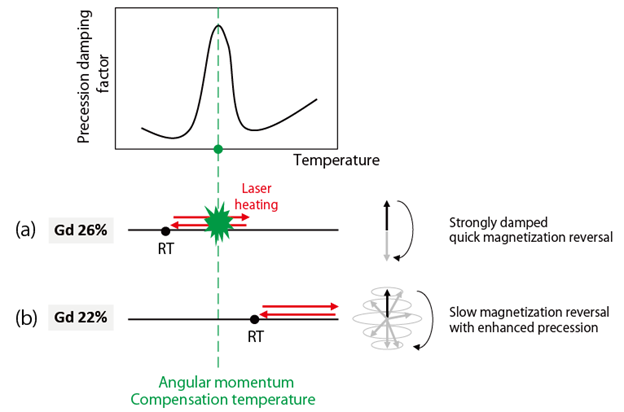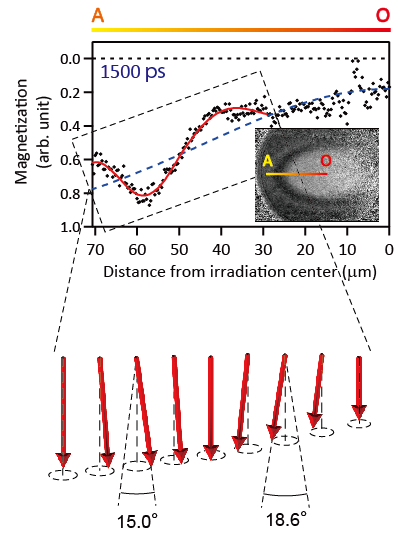Remarkable magnetic waves triggered by laser-pulse irradiation (Press Release)
- Release Date
- 13 Sep, 2017
- BL25SU (Soft X-ray Spectroscopy of Solid)
JASRI/SPring-8
Osaka University
Tohoku University
Nihon University
Aichi Medical University
Key research findings
・In ferrimagnetic Gd–Fe–Co thin films, remarkable magnetic waves triggered by optical excitation were found to propagate under certain conditions.
・First-ever visualization of magnetic waves propagating with an amplitude more than tenfold that of conventional waves.
・This research achievement is expected to be applied to devices converting optical signals to magnetic signals and to information communication systems using magnetic modulation.
Scientists at the Japan Synchrotron Radiation Research Institute (JASRI), Graduate School of Engineering Science of Osaka University, Tohoku University, Graduate School of Engineering of Osaka University, Nihon University, and Aichi Medical University jointly discovered the generation of remarkable magnetic waves triggered by irradiating magnetic alloy thin films with laser pulses*1. This research achievement is expected to be applied to the development of devices and communication systems using magnetic modulation. Recently, spintronics, a field of electronic engineering utilizing the degree of freedom of both electrons and spins*2 of materials, has been actively studied. In particular, the application of a new technique that uses magnetic waves (spin waves*3) generated in a material for information transmission is expected. The research group was successful in discovering remarkable spin waves with an amplitude more than tenfold that of conventional waves and in directly observing them. This was realized by temporally and spatially observing the behavior of spins in a ferrimagnetic Gd–Fe–Co thin film immediately after irradiation with laser pulses using synchrotron radiation generated at SPring-8*4. The phenomenon of the excitation of spin waves by laser pulses is well known. In this study, spin waves with unprecedently large amplitude were observed; the practical application of these spin waves to magnetic communication technology is expected. This study was carried out by a joint research group comprising the following members: JASRI [Takuo Ohkochi (research scientist), Toyohiko Kinoshita (chief scientist), Tetsuya Nakamura (associate chief scientist), and Masato Kotsugi (research scientist, currently Tokyo University of Science)], Graduate School of Engineering Science of Osaka University [Shigemasa Suga (professor emeritus, currently Jülich Research Center), Akira Sekiyama (professor), and Hidenori Fujiwara (assistant professor)], Tohoku University [Masakiyo Tsunoda (associate professor) and Hirokazu Takahashi (graduate student, currently TDK Corporation)], Jülich Research Center [Claus M. Schneider (professor) and Roman Adam (research scientist)], Graduate School of Engineering of Osaka University [Hideaki Kasai (professor emeritus, currently National Institute of Technology, Akashi College), Mamoru Sakaue (specially appointed professor, currently De La Salle University in the Philippines), and Elvis F. Arguelles (graduate student)], Nihon University [Arata Tsukamoto (professor)], and Aichi Medical University [Hiroto Kuroda (professor)]. The achievement of this study was published online in Applied Physical Express, published by the Publication Center for Pure and Applied Physics, on 12 September 2017. Reference |
This work was partially supported by a Grant-in-Aid for Scientific Research (S, 18101004) and Grants-in-Aid for Young Scientists (B, 26790076 and A, 17H04920) from the Japan Society for the Promotion of Science, Projects for Innovative Quantum Functional Materials (PIQFUM) of the Ministry of Education Culture, Sports, Science and Technology (MEXT), and the Photon and Quantum Basic Research Coordinated Development Program of MEXT.
【Figures】
Fig. 1 Schematic of spin waves
Upon applying an external force such as laser light or a high-frequency electric field or magnetic field, static spins (the source of the magnetic force) are known to start precession. The concurrent precession (nonpropagating spin wave) shown in Fig. 1(a) is considered to be a spin wave in a broad sense. The spin wave shown in Fig. 1(b) spatially forms a wavelike magnetization modulation (propagating spin waves) and has recently been attracting much attention. In this study, propagating spin waves were observed.
Fig. 2 Schematic of spin (magnet) directions of (a) general ferromagnetic material and
(b) ferrimagnetic material used in this study
The directions of spins of rare-earth elements (e.g., Gd) and transition-metal elements (e.g., Fe, Co) in a ferrimagnetic material are antiparallel to each other. The net magnetic force is determined by the magnitude of the magnetic force at each site. A compensation state, in which the magnetic forces in antiparallel direction are balanced and no magnetic force is generated, also exists depending on the alloy composition and temperature.
Fig. 3 Schematic of magnetization reversals induced by laser pulses of Gd–Fe–Co thin films
The spin dynamics is known to differ depending on the angular momentum compensation temperature TA of the films. When the Gd content is 26% (TA>RT), smooth spin reversal with strong damping is expected. When the Gd content is 22% (TA<RT), the sample temperature does not intercept TA and long-lasting spin precession is expected.
Fig. 4 Time-dependent magnetic images of the (a)Gd26% and (b)Gd22% samples, respectively
In the Gd26% sample, clear spin reversal is observed. However, in the Gd22% sample, wave-like magnetization modulation propagated isotropically along the radial direction.
Fig. 5 Spin distribution of Gd–Fe–Co film containing 22% of Gd at 1500 picoseconds after the laser pulse duration
A line profile of spin distribution (main graph), a magnetic image (inset image), and calculated distribution of spin directions (lower drawings) are shown. One can see propagating spin waves whose precession angle ranging 15–20 deg.
【Glossary】
*1 Pulse
Instantaneous light emission. The laser pulses used in this study have a very small pulse width of ~0.1 ps (one-trillionth of a second) and specimens are irradiated with the laser pulses with an extremely high intensity within this time period.
*2 Spin
Spin is a momentum generated when an electron moves as if it rotates around its axis. In an aggregate of atoms, a magnetic force is generated when spin directions are aligned.
*3 Spin wave
Spins are generally directed in a certain direction. When an external force such as a microwave or laser pulse is applied, spins start to concurrently precess around their static axis. It is considered that this results in spin waves in a broad sense (nonpropagating spin waves). When precession propagates while maintaining a phase difference between spins that start precession with the same frequency, waves of a finite wavelength are formed and are called spin waves in a narrow sense (propagating spin waves). Refer to Fig. 1 for details.
*4 SPring-8
The name “SPring-8” comes from “Super Photon ring-8 GeV”. It is owned by RIKEN and located in Harima Science Garden City, Hyogo Prefecture, Japan. SPring-8 generates the world's highest-performance synchrotron radiation and was opened in 1997 to users from universities, research institutes, and companies. Synchrotron radiation is an electromagnetic wave that is produced when electron beams, accelerated to nearly the speed of light, are bent in a high magnetic field. High-intensity synchrotron radiation in a wide range of energy from infrared to soft and hard X-ray regions is available at SPring-8.
For more information, please contact: SPring-8/SACLA |
- Previous Article
- Establishment of new method of evaluating performance of lithium-ion batteries using high-energy X-ray scattering (Press Release)
- Current article
- Remarkable magnetic waves triggered by laser-pulse irradiation (Press Release)





 spring8.or.jp
spring8.or.jp